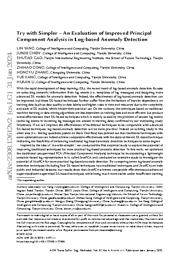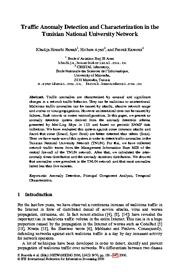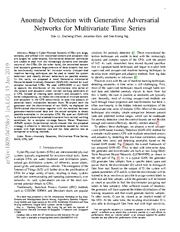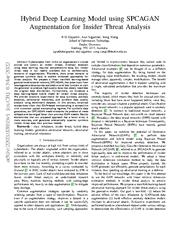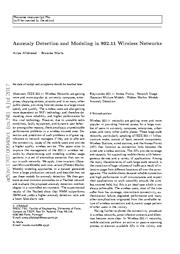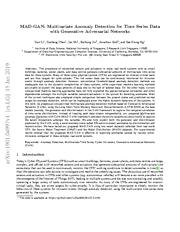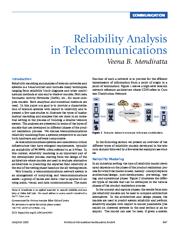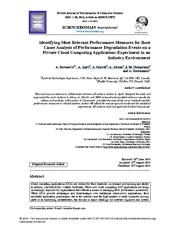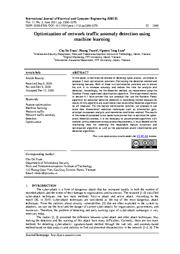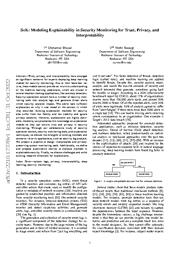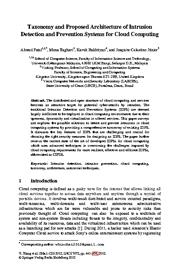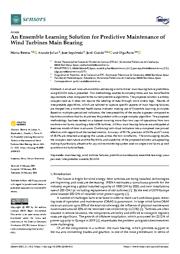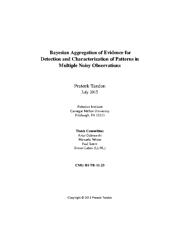A copy of this work was available on the public web and has been preserved in the Wayback Machine. The capture dates from 2024; you can also visit the original URL.
The file type is application/pdf.
Filters
Try with Simpler – An Evaluation of Improved Principal Component Analysis in Log-based Anomaly Detection
[article]
2024
arXiv
pre-print
The rapid growth of deep learning (DL) has spurred interest in enhancing log-based anomaly detection. ...
We optimized the unsupervised PCA (Principal Component Analysis), a traditional technique, by incorporating lightweight semantic-based log representation. ...
We would like to express our sincere appreciation to the anonymous reviewers and the editors for their constructive suggestions, which have greatly improved the quality of this paper. ...
arXiv:2308.12612v2
fatcat:qucx3istnjefxnoimemqvgzlz4
Traffic Anomaly Detection and Characterization in the Tunisian National University Network
[chapter]
2006
Lecture Notes in Computer Science
In this paper, we present an anomaly detection system derived from the anomaly detection schema presented by Mei-Ling Shyu in [12] and based on periodic SNMP data collection. ...
Then we have made use of this system in order to detect traffic anomalies in the Tunisian National University Network (TNUN). ...
Acknowledgement This work couldn't be achieved without the active cooperation of the Khawarizmi Calculus Center (CCK). ...
doi:10.1007/11753810_12
fatcat:qwmqm4b3srbwlic6mtdrvmxwsy
Anomaly Detection with Generative Adversarial Networks for Multivariate Time Series
[article]
2019
arXiv
pre-print
In this work, we proposed a novel Generative Adversarial Networks-based Anomaly Detection (GAN-AD) method for such complex networked CPSs. ...
possible anomalies in the complex CPS. ...
ACKNOWLEDGEMENT This material is based on research/work supported by the Singapore National Research Foundation and the Cybersecurity R&D Consortium Grant Office under Seed Grant Award No.CRDCG2017-S05 ...
arXiv:1809.04758v3
fatcat:lj24chtitba2lfyhxjnxbu556u
Hybrid Deep Learning Model using SPCAGAN Augmentation for Insider Threat Analysis
[article]
2022
arXiv
pre-print
In this context, empirical comparisons show that GAN-based oversampling is competitive with numerous typical oversampling regimes. ...
Anomaly detection using deep learning requires comprehensive data, but insider threat data is not readily available due to confidentiality concerns of organizations. ...
The contributions of the paper are : • We developed a linear manifold learning-based regularization for adversarial training that helps in improved insider threat analysis. • We propose an anomaly detection ...
arXiv:2203.02855v1
fatcat:naeat2lz4jg65bp2gaw2tzp25q
Anomaly Detection and Modeling in 802.11 Wireless Networks
2018
Journal of Network and Systems Management
We then generate several common anomalies on a Testbed network and evaluate the proposed anomaly detection methodologies in a controlled environment. ...
This paper aims to improve the management of the 802.11 wireless networks by characterizing and modeling wireless usage patterns in a set of anomalous scenarios that can occur in such networks. ...
-COMPETE 2020 Programme within project POCI-01-0145-FEDER-006961, and by National Funds through the FCT Fundao para a Cincia e a Tecnologia (Portuguese Foundation for Science and Technology) as part of ...
doi:10.1007/s10922-018-9455-2
fatcat:njoiqbyxlvcinfljo62kphmshq
MAD-GAN: Multivariate Anomaly Detection for Time Series Data with Generative Adversarial Networks
[article]
2019
arXiv
pre-print
In this work, we propose an unsupervised multivariate anomaly detection method based on Generative Adversarial Networks (GANs). ...
However, conventional threshold-based anomaly detection methods are inadequate due to the dynamic complexities of these systems, while supervised machine learning methods are unable to exploit the large ...
For linear model-based unsupervised anomaly detection methods, a popular approach is the Principal Component Analysis (PCA) [13] . ...
arXiv:1901.04997v1
fatcat:cl2oslliybeyrp4hqcvokuvxgi
A Unifying Review of Deep and Shallow Anomaly Detection
[article]
2020
arXiv
pre-print
Deep learning approaches to anomaly detection have recently improved the state of the art in detection performance on complex datasets such as large collections of images or text. ...
These results have sparked a renewed interest in the anomaly detection problem and led to the introduction of a great variety of new methods. ...
Principal Component Analysis A common way to formulate the Principal Component Analysis (PCA) objective is to seek an orthogonal basis W in data space X ⊆ R D that maximizes the empirical variance of the ...
arXiv:2009.11732v2
fatcat:4ppfpds3ivd3bk5xcdoxmzmlie
Reliability Analysis in Telecommunications
2020
Notices of the American Mathematical Society
The techniques used were: multivariate unsupervised learning with Principal Component Analysis (PCA) for anomaly detection, and finite state machines for root cause analyses. ...
[3] presents a good survey of the different log analysis techniques using machine learning for anomaly detection and prediction and root cause analysis. ...
doi:10.1090/noti2095
fatcat:36r3qqgslfcerlw463gecohpcy
Identifying Most Relevant Performance Measures for Root Cause Analysis of Performance Degradation Events on a Private Cloud Computing Application: Experiment in an Industry Environment
2016
British Journal of Mathematics & Computer Science
captured in performance logs, a source of data that is widely available in today's datacenters, and where detailed records of resource consumption and performance logs is captured from numerous systems ...
The experimentation required adjustments to the original proposal in order to determine, with the help of a multivariate statistical technique, the performance of a CCA from the perspective of an end-user ...
The anomaly detection algorithm was able to detect different occurrences of anomalies when an anomaly is defined as a difference of 25% of the value observed versus the forecasted value using the Holt-Winters ...
doi:10.9734/bjmcs/2016/27872
fatcat:w6vpil4aang5ney76avn4yj3ke
Optimization of network traffic anomaly detection using machine learning
2021
International Journal of Power Electronics and Drive Systems (IJPEDS)
For the feature optimization solution, we propose to use some data dimensional reduction techniques such as information gain, principal component analysis, and correlation coefficient method. ...
The results of the research proposed in our paper have proven that to optimize the cyber-attack detection process, it is not necessary to use advanced algorithms with complex and cumbersome computational ...
using principal component analysis method Principal component analysis (PCA) is a method of finding a new basis so that the information of the data is mainly concentrated in several coordinates, the remainder ...
doi:10.11591/ijece.v11i3.pp2360-2370
fatcat:vjp4ptdt45ec5je36yv7xj26wm
SoK: Modeling Explainability in Security Monitoring for Trust, Privacy, and Interpretability
[article]
2022
arXiv
pre-print
Due to their back-box nature, these models cannot provide an intuitive understanding of the machine learning predictions, which are crucial in several decision-making applications, like anomaly detection ...
as security log analysis. ...
give anomaly scores to system events based on a set of test statistics. [87] and [88] employ principal component analysis to monitor and detect abnormal traces in system logs. [51] uses invariant ...
arXiv:2210.17376v1
fatcat:kv7qv6vpsnghdakl2ads7gwriq
Taxonomy and Proposed Architecture of Intrusion Detection and Prevention Systems for Cloud Computing
[chapter]
2012
Lecture Notes in Computer Science
This paper surveys and explores the possible solutions to detect and prevent intrusions in cloud computing systems by providing a comprehensive taxonomy of existing IDPS. ...
The distributed and open structure of cloud computing and services becomes an attractive target for potential cyber-attacks by intruders. ...
It means that generated logs by the intruder who has the highest anomaly level or security risk are audited with higher priority. ...
doi:10.1007/978-3-642-35362-8_33
fatcat:tmq6ndhbojblfdym6g6lsln5ta
An Ensemble Learning Solution for Predictive Maintenance of Wind Turbines Main Bearing
2021
Sensors
Based on multiple specialized indicators, the interpretability of the results is greater compared to black-box solutions that try to address the problem with a single complex algorithm. ...
All four main bearing failures are anticipated at least one month of time in advance. Combining individual indicators into a composed one proved effective with regard to all the tracked metrics. ...
Acknowledgments: The authors want to acknowledge the support of the other colleagues at SMARTIVE for their support and technical advice in the design of this experiment and the analysis of the results. ...
doi:10.3390/s21041512
pmid:33671601
fatcat:bwvxalvydzbt5ei7g46d6ajyii
G-IDS: Generative Adversarial Networks Assisted Intrusion Detection System
[article]
2020
arXiv
pre-print
In this paper, we propose a generative adversarial network (GAN) based intrusion detection system (G-IDS), where GAN generates synthetic samples, and IDS gets trained on them along with the original ones ...
We model a network security dataset for an emerging CPS using NSL KDD-99 dataset and evaluate our proposed model's performance using different metrics. ...
Anomaly-based IDS learns the distribution of data in the training process. If the new coming data is not from the same distribution, it is detected as an anomaly. ...
arXiv:2006.00676v1
fatcat:5vrd3jrdxzej7gmyv4trjtmqay
Bayesian aggregation of evidence for detection and characterization of patterns in multiple noisy observations
2016
AI Matters
Respondents should be aware that notwithstanding any other provision of law, no person shall be subject to a penalty for failing to comply with a collection of information if it does not display a currently ...
the data needed, and completing and reviewing the collection of information. ...
Principal Component Analysis Principal Component Analysis (PCA) is an algorithm for explaining variation in data [7] . ...
doi:10.1145/2911172.2911181
fatcat:ubasoab2kjealptezfkxa6qvc4
« Previous
Showing results 1 — 15 out of 3,478 results

